
Posted on 11/28/2012 4:28:05 AM PST by Homer_J_Simpson

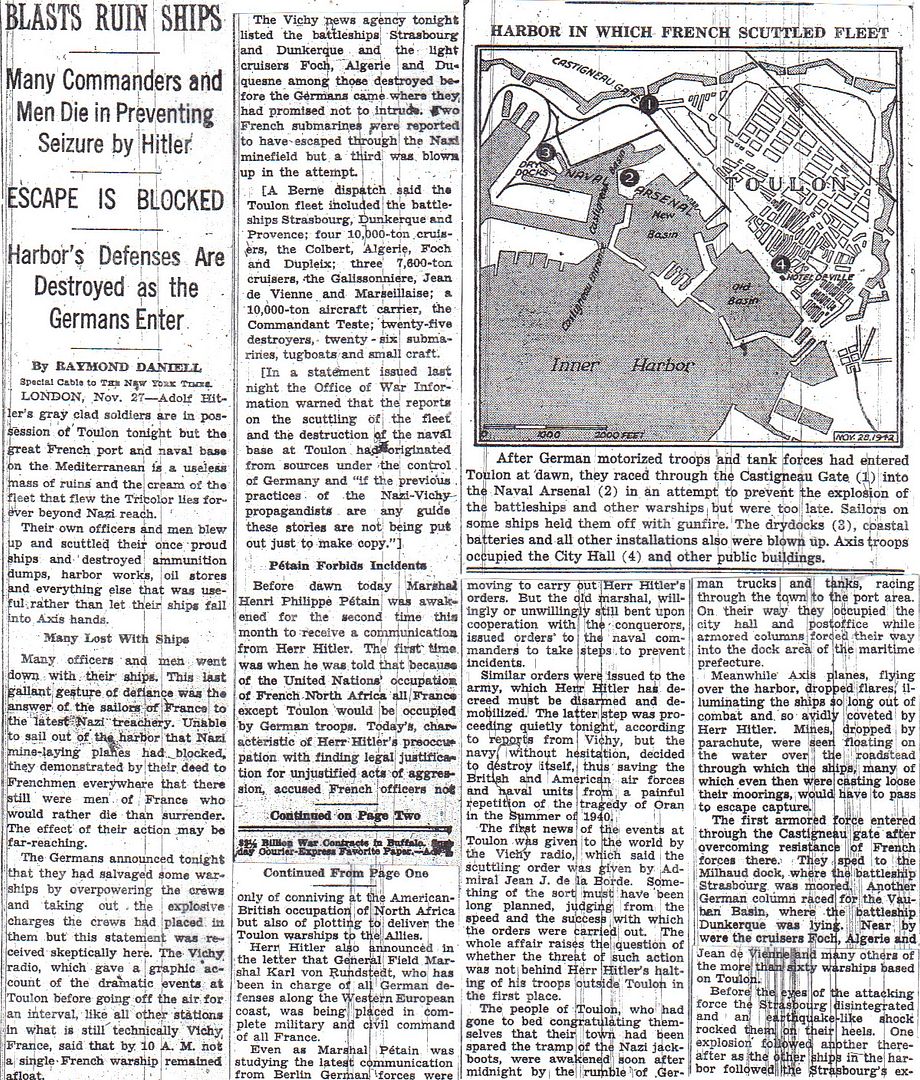
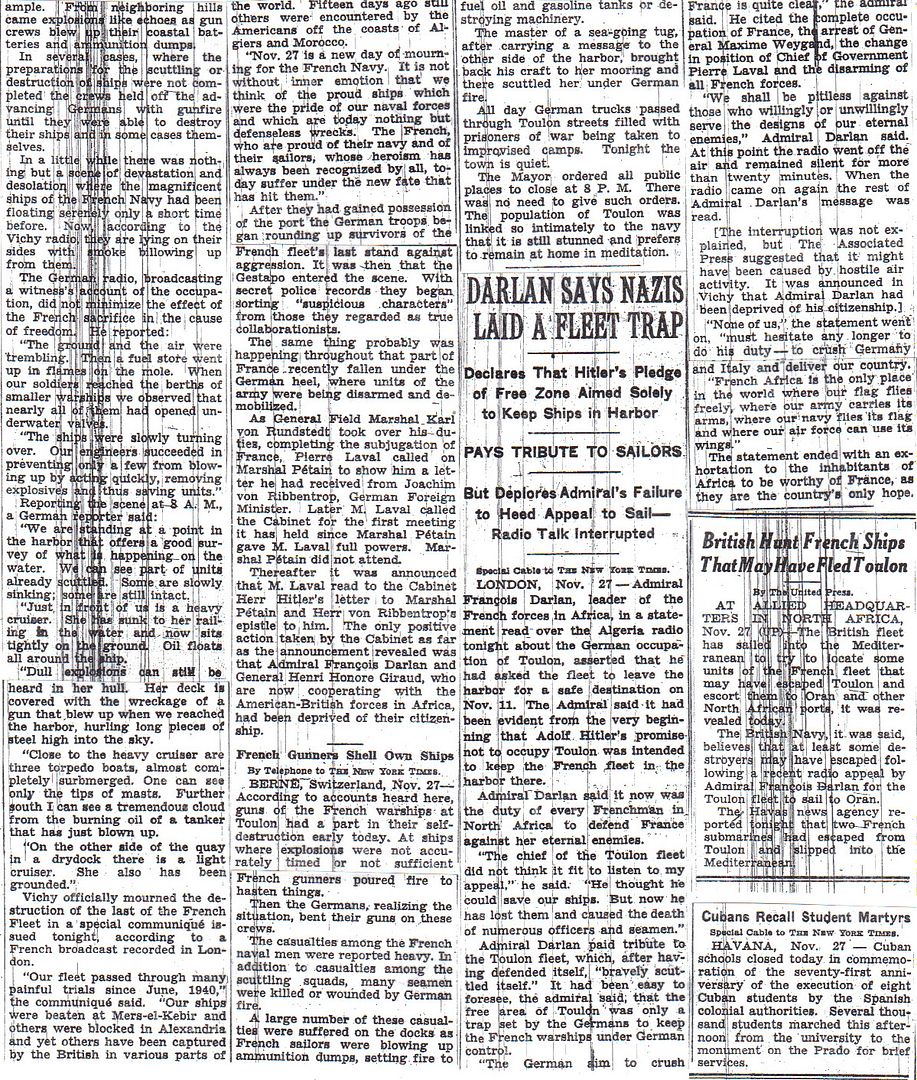
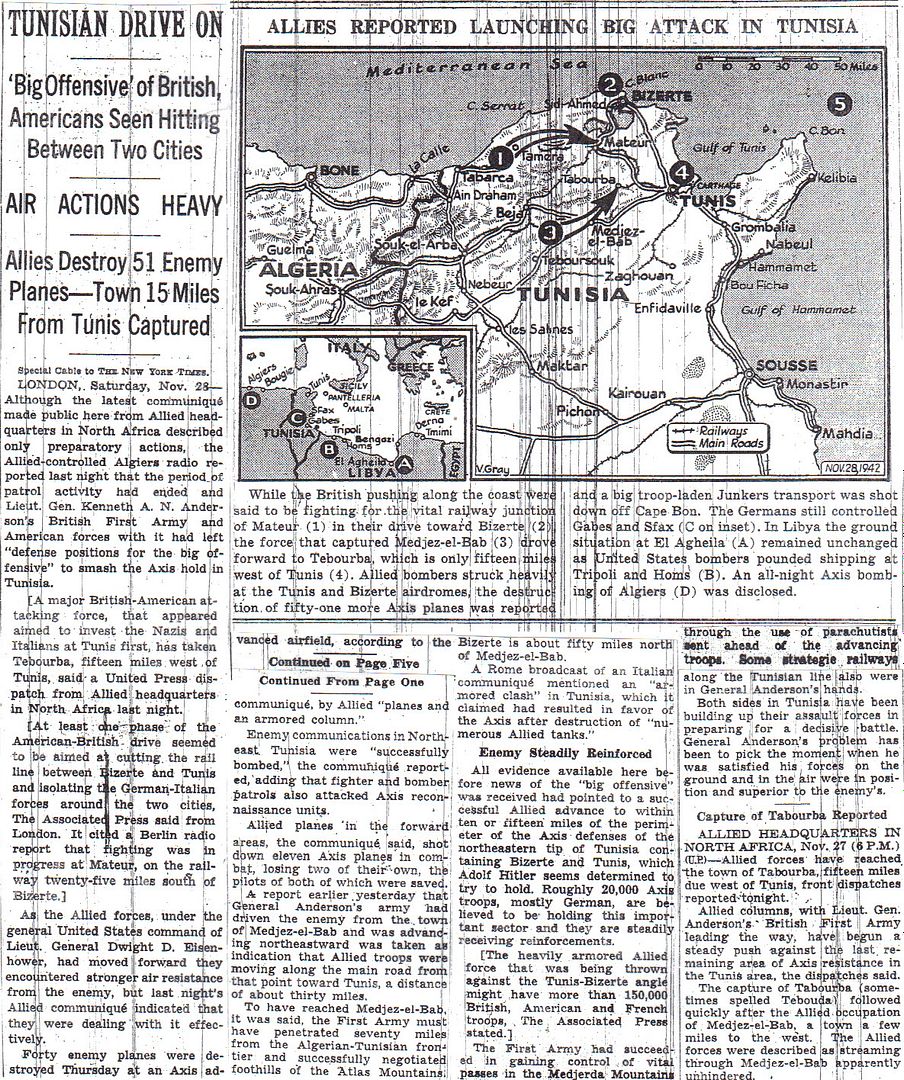
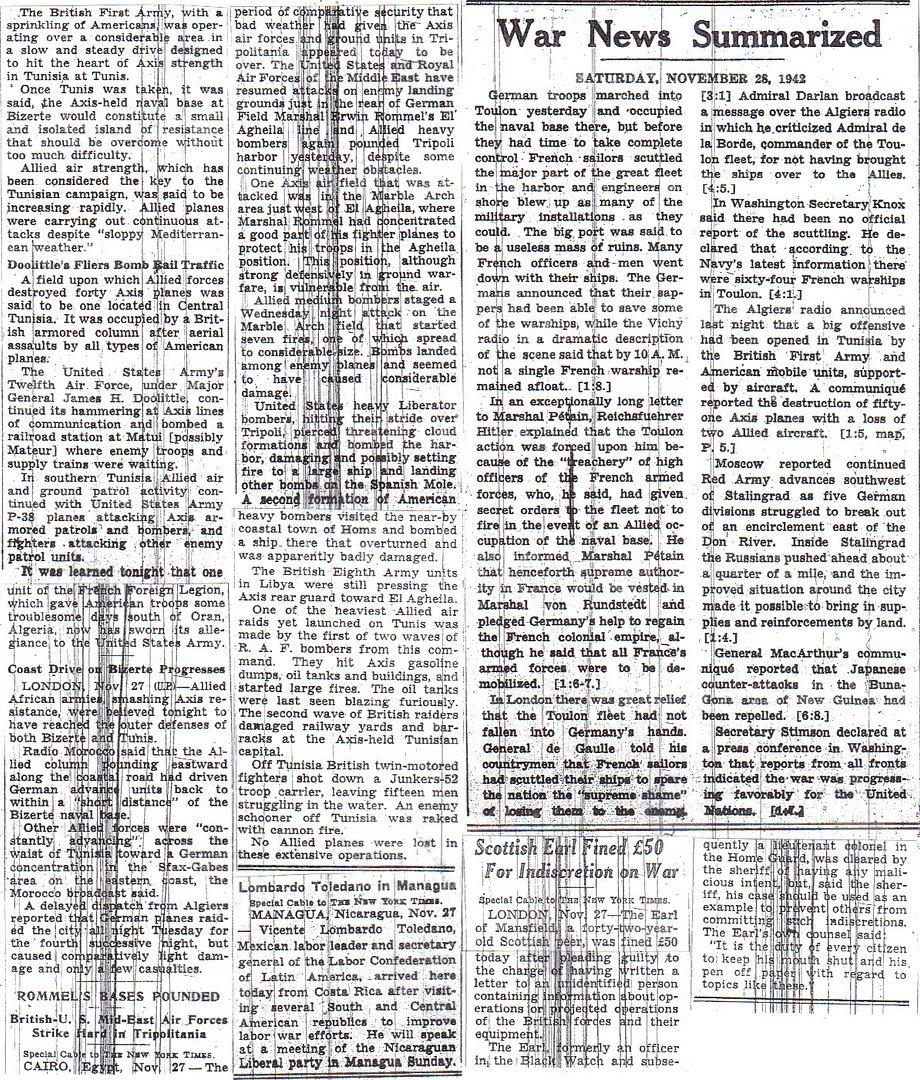
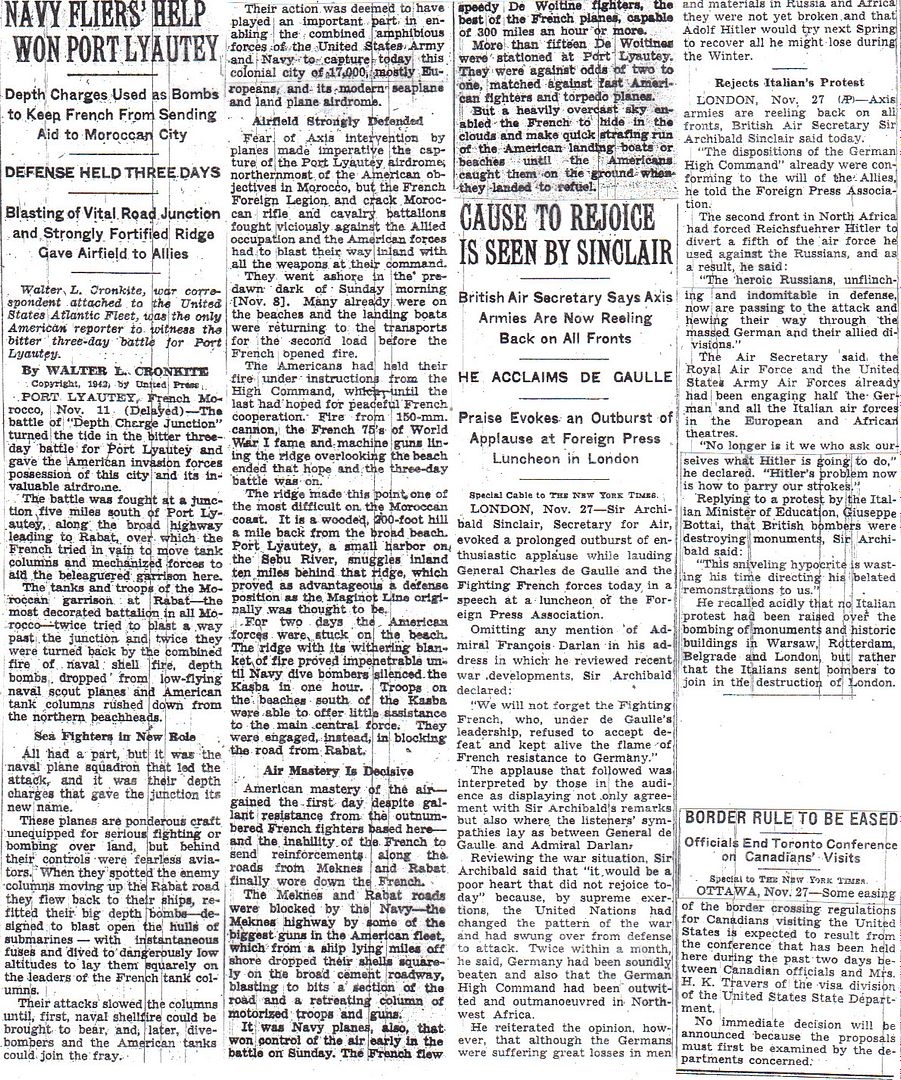
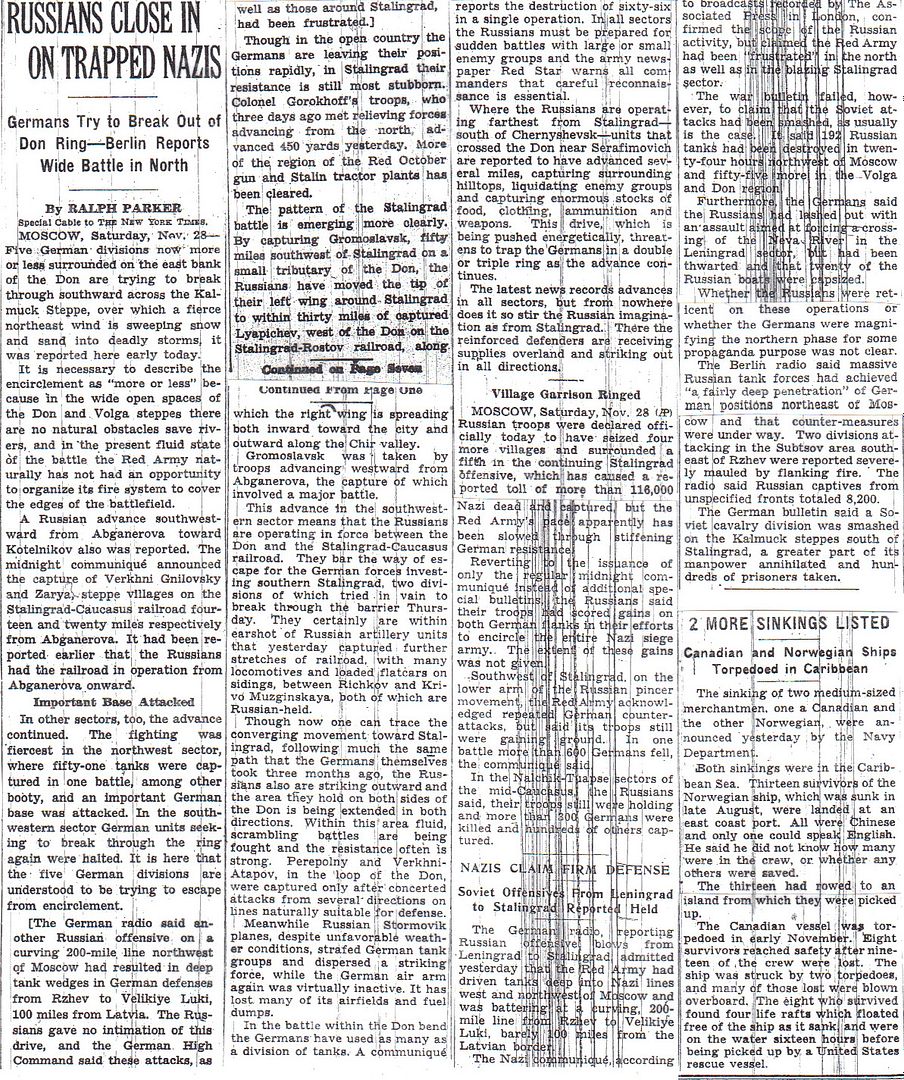
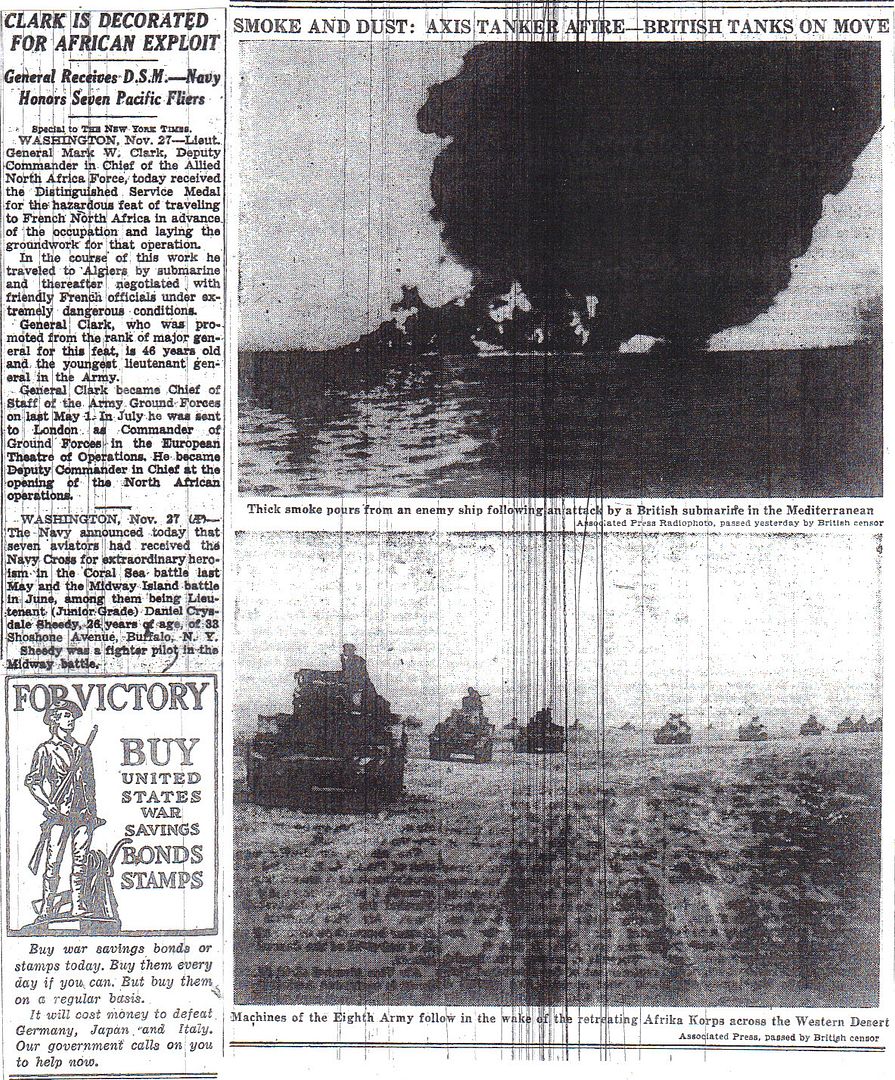

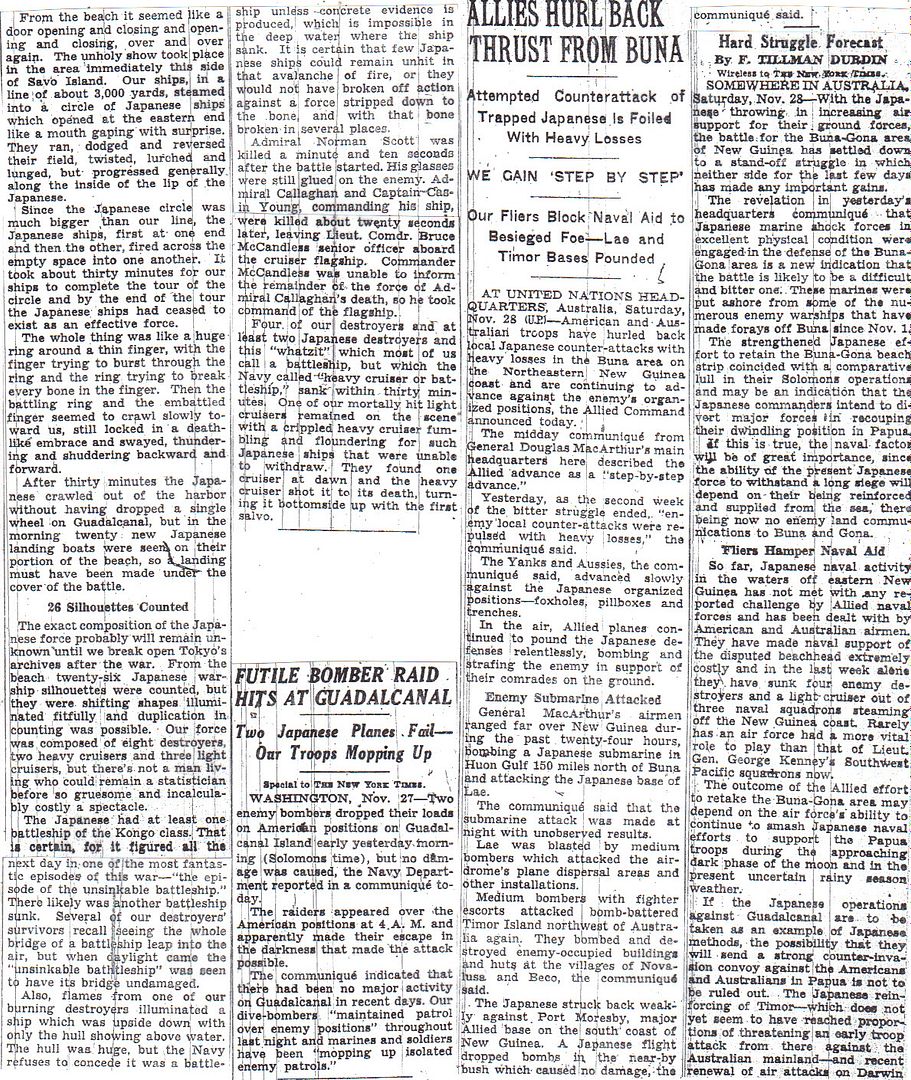
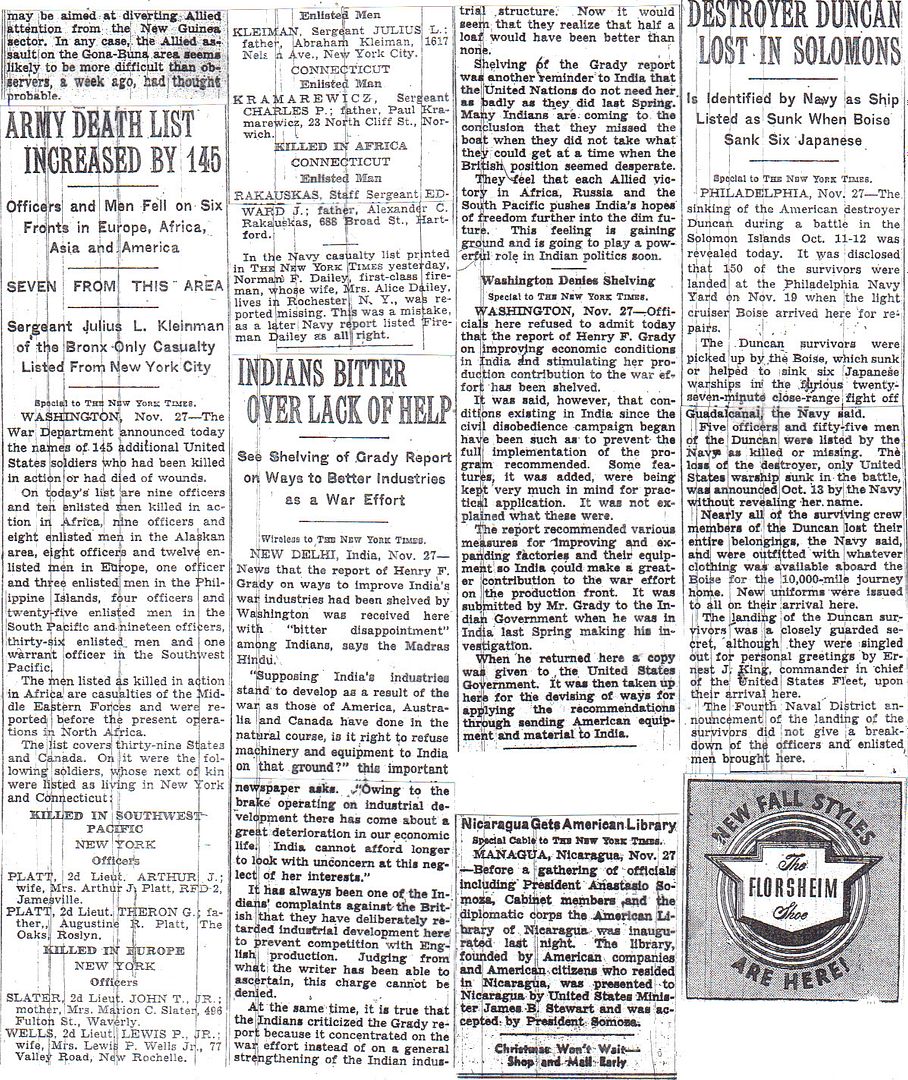
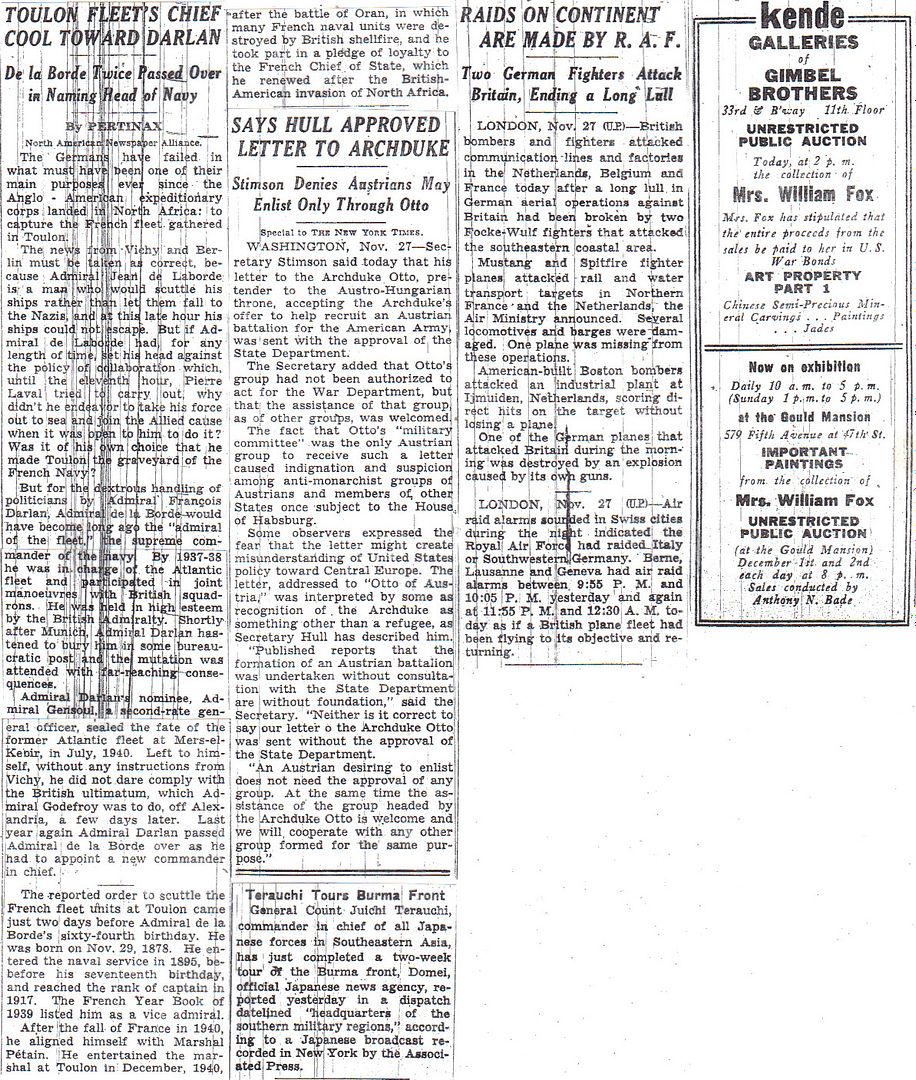
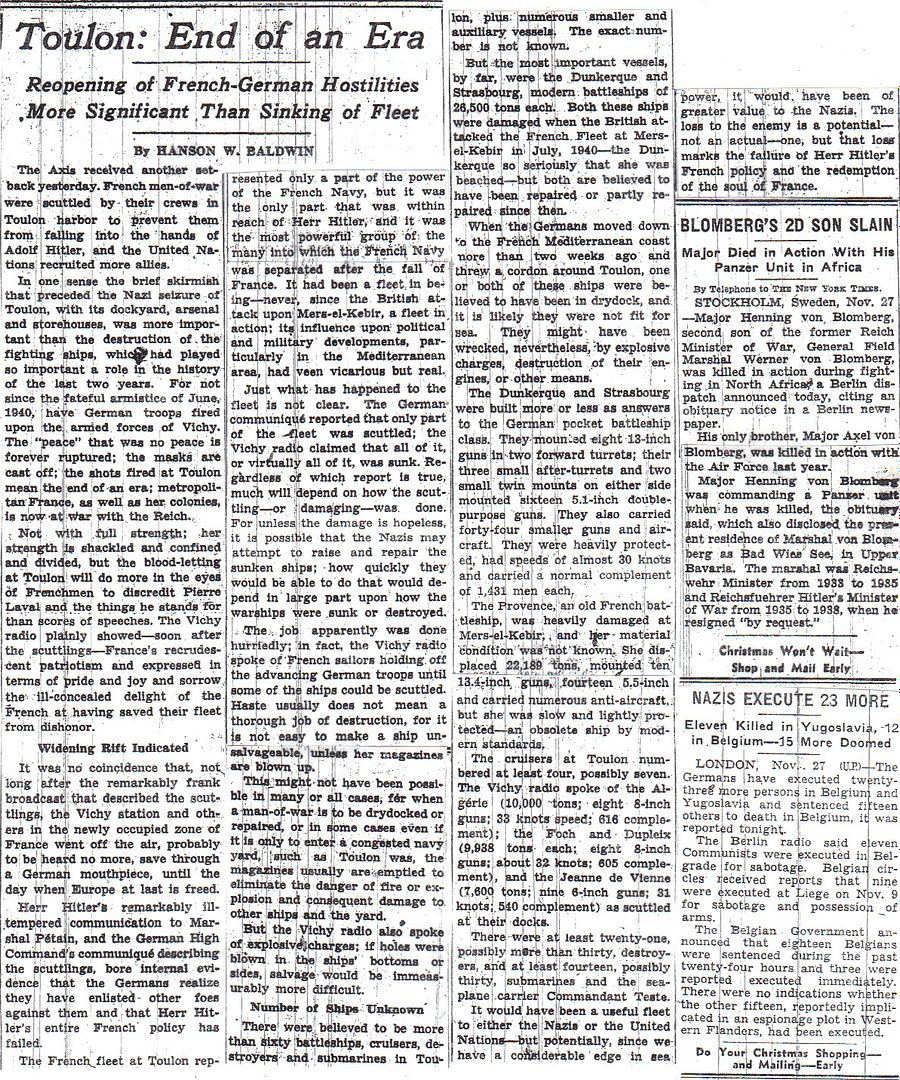


Pray convey to all those in your department who have contributed to the success of “Torch” my warm congratulations and thanks for the part they played in the preparation and movement of this great armada. It owed much to their skill, industry, and reticence, and they share in the honour of a great achievement.
Winston S. Churchill, The Hinge of Fate
#1 - “White Christmas” - Bing Crosby
#2 - “Praise the Lord and Pass the Ammunition” - Kay Kyser, with Glee Club
#3 - “Serenade in Blue” - Glenn Miller, with Ray Eberly and the Modernaires
#4 – “When the Lights Go On Again All Over the World” - Vaughn Monroe
#5 – “Der Fuehrer’s Face,” Spike Jones, with Carl Grayson
#6 - “Mister Five by Five” – Harry James, with Helen Forrest
#7 - “(I’ve Got a Girl) In Kalamazoo” - Glenn Miller, with Marion Hutton, Tex Beneke & the Modernaires
#8 – “Praise the Lord and Pass the Ammunition” - The Merry Macs
#9 - “Manhattan Serenade” - Harry James, with Helen Forrest
#10 - “There Are Such Things” - Tommy Dorsey, with Frank Sinatra and the Pied Pipers
Battle for Stalingrad: 70 Years After.
Blasts Ruin Ships (Daniell) – 2-3
Darlan Says Nazis Laid a Fleet Trap – 3
Tunisian Drive On – 4-5
War News Summarized – 5
Navy Fliers’ Help Won Port Lyautey (by Walter L. Cronkite, first-time contributor) – 6
Russians Close In on Trapped Nazis (Parker) – 7
Smoke and Dust: Axis Tanker Afire – British Tanks on Move (photos) – 8
Solomns Battle a Fiery Spectacle (Wolfert) – 9-10
Allies Hurl Back Thrust from Buna (Durdin) – 10-11
Army Death List Increased by 145 – 11
Destroyer Duncan Lost in Solomons – 11
Toulon: End of an Era (Baldwin) – 13
The Texts of the Day’s Communiques on the Fighting in Various War Zones – 14-15
Battle for Stalingrad: 70 Years After.
Blasts Ruin Ships (Daniell) – 2-3
Darlan Says Nazis Laid a Fleet Trap – 3
Tunisian Drive On – 4-5
War News Summarized – 5
Navy Fliers’ Help Won Port Lyautey (by Walter L. Cronkite, first-time contributor) – 6
Russians Close In on Trapped Nazis (Parker) – 7
Smoke and Dust: Axis Tanker Afire – British Tanks on Move (photos) – 8
Solomns Battle a Fiery Spectacle (Wolfert) – 9-10
Allies Hurl Back Thrust from Buna (Durdin) – 10-11
Army Death List Increased by 145 – 11
Destroyer Duncan Lost in Solomons – 11
Toulon: End of an Era (Baldwin) – 13
The Texts of the Day’s Communiques on the Fighting in Various War Zones – 14-15
http://www.onwar.com/chrono/1942/nov42/f28nov42.htm
Red Army advancing around Rzhev
Saturday, November 28, 1942 www.onwar.com
On the Eastern Front... Soviet advances continue in the area around Rzhev in the Moscow area.
In North Africa... British and American forces of the brigade strength take Djedeida. However German forces are advancing from St. Cyprien at their rear.
In the Indian Ocean... Free French forces occupy the island of Reunion.
http://homepage.ntlworld.com/andrew.etherington/frame.htm
November 28th, 1942
UNITED KINGDOM: Destroyers HMS Talybont and Barfleur laid down. (Dave Shirlaw)
VICHY FRANCE: The Vichy admiralty issued statement on the scuttling of the fleet at Toulon. Action was taken “in accordance with the standing instruction dating from the time of the Franco-German armistice, which had ordered the fleet to scuttle rather than be taken over by a foreign power. When the Vichy Ministers for the Navy, Army, and Air Force were informed of the German Government’s decision to occupy Toulon, Admiral Abrial tried immediately to get in touch with the local authorities at Toulon, but could not do so” . (Dave Shirlaw)
GERMANY: Rastenburg: Hitler refuses Rommel’s plea to evacuate German forces from North Africa.
The government announces that all men between the ages of 18 and 45 are now reservists. (P.T. Holscher)
U-424 launched.
U-199, U-232, U-341 commissioned. (Dave Shirlaw)
U.S.S.R.: The Soviet Army advances in the central sector near Rzhev.
MEDITERRANEAN SEA: Destroyer HMS Ithuriel bombed and sunk at Bone. (Dave Shirlaw)
TUNISIA: As German troops approach their rear, Allied forces capture Djedeida and meet firm German resistance.
INDIAN OCEAN: St. Denis Reunion: The LEOPARD, a Free French destroyers, berthed on this Vichy-controlled island in the Indian Ocean this morning to a jubilant, almost operatic, welcome.
After discussion with the destroyer’s captain, Commander Jacques Richard, the governor, M. Aubert, ended three hours of hostilities with no casualties. This is the second blow to Vichy’s colonies in two days. Yesterday troops in Djibouti, in the Horn of Africa, crossed the frontier into British Somaliland and placed themselves at the disposal of the Free French. Meanwhile in Vichy France the Germans are forcibly demobilising the French Armistice Army.
U-177 sank SS Nova Scotia and rescued two crewmembers.
CANADA: Minesweeper HMS Mariner (ex-HMCS Kincardine) and Marmion (ex-HMCS Orangeville) ordered. (Dave Shirlaw)
U.S.A.: Admiral Carleton Wright, USN, is placed in command of US naval TF 67 replacng Admiral Kincaid. Admiral Kincaid has been transferred to the North Pacific area.
There is a fire in the Cocoanut Grove Lounge in Boston, Massachusetts. This fire flashes through the entire building. There are 492 dead. The use of Methyl Chloride gas as a substitute for freon in the cooling system is suspected of contributing to the massive lass of life. The owner of the club is convicted of several fire safety violations.
Ensigns George W. Carlson and Mac A. Cason, SC, USNR organize rescue parties to help rescue people from the fire at the Coconut Grove nightclub in Boston, MA. They are credited “the cause of saving more lives than any other single agency.” A very popular venue, the club had been decorated wholesale for the holidays, and that night the place was packed with every sort of person from odd tourists to people celebrating a college football victory, and numerous military personnel. It had a 600-person occupancy permit, but about 1,000 were in there. A 16-year-old busboy lit a match to replace a bulb removed by a patron. Somehow the small flame caught a bit of an artificial palm tree decoration, and within 12 to 15 minutes the entire place was ablaze. Its two revolving doors quickly jammed shut against a mob trying to escape. En fin, 492 perished in the blaze, and another 166 were injured. Among the dead was Charles “Buck” Jones, long a very popular film actor in serial Westerns. This disaster prompted a succession of heavy-duty reforms in fire prevention and escape planning for all buildings in public use. These included requiring regular doors that opened outward on each side of any revolving door; that exits be all outward hinged, be numerous, and be marked with lit-up red EXIT signs all the time; that decorations be made of fire-resistant materials; requiring sprinkler systems; and many other reforms and changes to building code and use rules.
Rationing of coffee begins. (P.T. Holscher)
Minesweeper USS Vigilance laid down. (Dave Shirlaw)
ATLANTIC OCEAN:
U-67 damaged SS Empire Glade.
U-508 sank SS Empire Cromwell.
U-181 sank SS Evanthia.
U-172 sank SS Alaskan.
U-519 transferred an ill crewmember to U-118 in the mid-Atlantic. (Dave Shirlaw)
Petain
what a worm
#2 - “Praise the Lord and Pass the Ammunition” - Kay Kyser, with Glee Club
I had not noticed the name of Walter L. Cronkite in this series until now. Whatever became of him?
STALINGRAD is on the same parallel as Vienna, Paris, or Vancouver. At that latitude the temperature in early November is still fairly mild. That was why General Strecker, commanding XI Corps in the great Don bend, was still wearing his lightweight overcoat as he drove to the headquarters of the Austrian 44th Infantry Division, the Hoch-und-Deutschmeister Division.
In the fields the soldiers were busy lifting potatoes and fodder beet, and raking maize straw and hay—supplies for the winter.
General Strecker's XI Corps was to have covered the left flank of Stalingrad along the big Don bend. But this loop of the river was 60 miles long—and 60 miles cannot be held by three divisions. As a result, the general was compelled to adopt a position along a chord of the arc; in this way he saved about 30 miles, but it meant surrendering to the Soviets the riverbend at Kremenskaya.
Lieutenant-General Batov, commanding the Soviet Sixty-fifth Army, immediately seized his opportunity, crossed the Don, and was now established in a relatively deep bridgehead on the southern bank. Batov's regiments made daily attacks on the positions of Strecker's divisions in an attempt to bring about the collapse of the German flank on the Don. But Strecker's divisions were established in good positions. Colonel Boje, for instance, when he welcomed the Corps Commander at the headquarters of 134th Infantry Regiment, was able to point to such a clever system of positions on the high ground behind the river that he confidently assured him: "There will be no Russian getting through here, Herr General."
Strecker asked for very detailed reports, especially about everything that had been noticed from the division's observation post at the edge of a small wood south-west of Sirotinskaya since the end of October. From the edge of that wood there was an excellent view far across the Don. Through the trench telescope it was even possible to make out the German positions of VIII Corps all the way across to the Volga.
But above all the enemy's hinterland lay revealed to the eye, like a relief map. And, indeed, a great many significant moves had been spotted: the Russians were bringing up troops and materials to the Don in continuous day-and-night transports, both against Strecker's front and against that of the Rumanian Third Army adjoining it on the left.
Anxiously Corps headquarters recorded these reports every evening. They were fully confirmed by aerial reconnaissance of Fourth Air Fleet. Every morning Strecker passed the reports on to Golubinskaya, where General Paulus had his headquarters. And Paulus, in turn, had been passing the reports on to Army Group since the end of October. Army Group's reports to the Fuehrer's Headquarters stated: The Russians are deploying in the deep flank of Sixth Army.
On this flank along the Don there stood, next to Strecker's Corps, the Rumanian Third Army along a front of about 90 miles. Next to it was the Italian Eighth Army, and next to that the Hungarian Second Army. "Why is such a broad sector held only by Rumanians, Herr-General?" the staff officers would ask their GOC.
They had nothing against the Rumanians—they were brave soldiers— but it was common knowledge that their equipment was pitiful, even more pitiful than that of the Italians. Their weapons were antiquated, they lacked adequate anti-tank equipment, and their supplies were insufficient. Everybody knew that.
But Marshal Antonescu, the Rumanian Head of State, had insisted—as had also Italy's Mussolini—that the forces he was making available for the Eastern Front must be employed as complete units only, and under their own officers. Hitler had reluctantly agreed, although he would have preferred to follow his generals' advice to adopt the "boned corset" method— i.e., to employ alternate foreign and German formations, the latter acting as stiffening units.
This idea, however, was ruled out by the national susceptibilities of Germany's allies. As a result, the flank cover of the main German forces at Stalingrad, with their thirteen infantry divisions, three motorized divisions and three Panzer divisions, was entrusted to foreign Armies whose operational effectiveness was inadequate.
Naturally, Hitler too read the reports about Soviet troop concentrations opposite the Rumanian front. At his situation conferences he heard the Rumanian Colonel-General Dumitrescu warn of the danger and ask that the Rumanian Third Army should be given anti-tank and Panzer formations to support it, or else should be allowed to shorten its front. To shorten a front was a proposal which invariably aroused Hitler's indignation.
To yield ground was not part of his tactics. He wanted to hold everything, forgetting Frederick the Great's old adage: "He who would defend everything defends nothing at all."
In judging the situation on the Don front in the autumn of 1942 Hitler was confirmed in his optimistic assessment by a paper prepared by the Army General Staff, a document so far not widely known. This suggested that an analysis of the General Staff section for "Foreign Armies East" of 9th September 1942 showed that the Russians had no operational reserves of any importance left on the Eastern Front. This Hitler was only too ready to believe. Why then yield ground?
As for the Rumanians' request for anti-tank and Panzer support, Hitler proved reasonable. But the only major formation that could be made available and directed behind the Rumanian Third Army—apart from a few formations of flak, Panzers, Jäger battalions, and Army artillery—was Lieutenant-General Heim's XLVIII Panzer Corps with one German and one Rumanian Panzer division, as well as units of 14th Panzer Division. This Corps was temporarily detached from Fourth Panzer Army and transferred to the area south of Serafimovich.
Normally a German Panzer Corps represented a very considerable fighting force, and more than adequate support for an infantry Army. It would have been quite sufficient to protect the threatened front of the Rumanian Third Army. But Heim's Corps was anything but a Corps. Its centre-piece was the German 22nd Panzer Division. This division had been lying behind the Italian Eighth Army since September in order to be rested and replenished. Contrary to the plans of the Army High Command, it had been only partially re-equipped with German tanks, to take the place of the Czech-manufactured ones, and as yet had few Mark Ills and Mark IVs. Moreover, the division had parted with its 140th Panzer Grenadier Regiment under Colonel Michalik a few months before to send it to Second Army in the Voronezh area. There the "Brigade Michalik" was made into 27th Panzer Division.
The division's Panzer Engineers Battalion finally had been engaged in street fighting in Stalingrad for several weeks. It is important to remember these facts to understand with what kind of shadow unit the German High Command was hoping to meet a very palpable threat to the Rumanian front on the Don.
Was Hitler aware of all this?
Was he informed of the fact that 22nd Panzer Division had not yet been re-equipped?
There are many indications that this had been kept from him. On 10th November Corps headquarters and 22nd Panzer Division received orders for the division to move into the sector of the Rumanian Third Army. The division's last units left for the south on 16th November, making for the big Don loop. It was a 150-mile journey through frost and snow. But neither the frost nor the snow was the main problem. There seemed to be a jinx on this Panzer Corps: one nasty surprise was followed by another.
While stationed on a "quiet front" the 22nd Panzer Division had received practically no fuel for training or testing runs. Its 204th Panzer Regiment, consequently, had been lying scattered behind the Italian Don front, camouflaged under reeds and entirely immobile. The tanks had been well hidden in pits dug into the ground and protected against the frost with straw.
The Panzer men had been unable to convince their superior commands that a motorized unit must keep its vehicles moving even during rest periods, and for that purpose required fuel. But no fuel was assigned to it, and engines therefore could not be tested. That then was how Colonel von Oppeln-Bronikowski found the 204th Panzer Regiment shortly before it was moved. When departure was suddenly decided upon and the tanks were to be brought out hurriedly from their pits, only 39 out of 104 could be started up, and that only with difficulty. A further 34 dropped out in the course of the move: the engines simply conked out and the turrets of many tanks refused to turn. In short, the electrical equipment broke down.
What had happened?
The answer is staggeringly simple. Mice, nesting in the straw with which the tank-pits were covered, had entered the tanks in search of food and had nibbled the rubber insulation of the wiring. As a result, faults developed in the electrical equipment, and ignition, battery-feeds, turret-sights, and tank guns were out of action. Indeed, several Panzers caught fire from short circuits and sparking. And since disasters never come singly, there was a severe drop in temperature just as the unit set out on its march—but the Panzer Regiment had no track-sleeves for winter operations. Somewhere these had been lost on the long journey to the Don.
The result was that the tanks slithered from one side of the icy roads to the other and made only very slow headway. The Tank Workshop Company 204 had not been taken along on this move because of fuel shortage, which meant that no major repairs could be carried out en route. Instead of the 104 tanks listed in the Army Group records as constituting the strength of 22nd Panzer Division, the Division in fact reached the assembly area of XLVIII Panzer Corps with 31 armored fighting vehicles. Another 11 followed later.
On 19th November, therefore, the Division could boast 42 armored vehicles—just about enough to amalgamate the tanks, armored carriers, and motor-cycles, as well as a motorized battery, under the name of Panzer Combat Group Oppeln.
The second major formation of the Corps—the Rumanian 1st Panzer Division—had 108 tanks at its disposal on 19th November. But of that total 98 were Czech 38-T types—perfectly good armored fighting vehicles, but inferior in armor and fire-power even to the Soviet medium tanks. The "corset boning" designed to stiffen the Rumanian Third Army on the middle Don about mid-November was therefore no real stiffening at all. Yet it was here that the Russian Armies were massing.
November 1942 was a month of disasters. On 4th November Rommel's Africa Army was badly mauled by Montgomery at El Alamein and had to save itself by withdrawing from Egypt into Tripoli. Four days later Eisenhower's invasion army landed in the rear of the retreating German forces, on the west coast of Africa, and started advancing on Tunis. The long-range effects of the shocks in Africa were felt on all German fronts. Hitler now found himself compelled to secure also that part of Southern France which had hitherto been unoccupied. As a result, four magnificently equipped major mobile formations, which might otherwise have been available for the Eastern Front, were tied down in France— the 7th Panzer Division, and the " Leibstandarte," " Reich," and " Death's Head " Waffen SS Divisions.
Against the firepower and effective combat strength of these four divisions Chuykov with his troops on the Volga bank would not have stood up for forty-eight hours.
On 9th November Hitler returned to Berchtesgaden from a visit to the Munich Lowenbrau Cellar, where he had assured his old comrades of the 1923 putsch: "No power on earth will force us out of Stalingrad again!"
Jodl now handed him the latest reports. They indicated that the Russians were deploying not only north-west of Stalingrad, on the middle Don, opposite the Rumanian Third Army, but also south of the hotly contested city, where two Corps of the Rumanian Fourth Army were covering the flank of Hoth's Fourth Panzer Army. These Soviet moves, reported from various sources, indicated an early attack.
Scowling, Hitler read the reports and bent down over his map. One glance was enough to show him what was at stake. The Soviet deployment along both wings of the Stalingrad front suggested an intended pincer operation against Sixth Army. Although he was still inclined to under-rate Soviet reserves, Hitler nevertheless realized the danger threatening along the extensive Rumanian sectors of the front. "If only this front were held by German formations I wouldn't lose a moment's sleep over it," he observed. "But this is different. The Sixth Army really must make an end of this business and take the remaining parts of Stalingrad quickly."
Quick action was what Hitler wanted. He was anxious to put an end to the strategically useless tying down of so many divisions in one city; he wanted to regain his freedom of operation. "The difficulties of the fighting at Stalingrad and the reduced combat strength of the units are well known to me," the Fuehrer said in a radio message to General Paulus on 16th November. "But the difficulties on the Russian side must be even greater just now with the ice drifting down the Volga. If we make good use of this period of time we shall save a lot of blood later on. I therefore expect that the commanders will once again display their oft-proved energy, and that the troops will once again fight with their usual dash in order to break through to the Volga, at least at the ordnance factory and the metallurgical works, and to take these parts of the city."
Hitler was right about Russian difficulties due to the ice on the river. This is confirmed by Lieutenant-General Chuykov's notes. In connection with the situation reports of the Soviet Sixty-second Army and its supply difficulties, Chuykov observes in his diary: "14th November. The troops are short of ammunition and food. The drifting ice has cut communications with the left bank.
"27th November. Supplies of ammunition and evacuation of wounded have had to be suspended."
The Soviet Command thereupon got Po-2 aircraft to carry ammunition and foodstuffs across the Volga. But these machines were not much help since they had to drop their cargoes over a strip only about 100 yards wide. The slightest error, and the supplies dropped either into the river or into enemy hands.
Paulus had Hitler's message urging him to make a quick end at Stalingrad read out to all commanding officers on 17th November. On 18th November the assault parties of the Stalingrad divisions renewed their attack. They hoped that this would be the final charge.
And so they stormed against the Russian positions—the emaciated men of Engineers Battalions 50, 162, 294, and 336. The grenadiers of 305th Infantry Division leapt out of their dug-outs, bent double, weapons at the ready, knapsacks bulging with hand-grenades. Panting, they dragged machine-guns and mortars across the pitted ground and through the maze of ruined factory buildings.
Bunched around self-propelled AA guns, behind tanks or assault guns, they attacked—amid the screaming roar of Stukas and the rattle of enemy machine-guns. Soaked to the skin by drizzling rain and driving snow, filthy, their uniforms in tatters. But they stormed—at the landing-stage of the ferry, at the bread factory, at the grain elevator, among the sidings of the "tennis racket." On their first day they "conquered" 30, 50, or even 100 yards. They were gaining ground—slowly but surely. Another twenty-four hours, or perhaps forty-eight hours, and the job would be done.
However, on the following morning, 19th November, at first light, just as the assault parties were resuming their step-bystep advance through the labyrinth of masonry among the factory buildings, storming barricades made of old Russian gunbarrels, flinging explosive charges down manholes into effluent tunnels, slowly inching their way to the Volga bank, the Russians launched their attack against the Rumanian Third Army on the Don, 90 miles away to the north-west.
Colonel-General von Richthofen, commanding Fourth Air Fleet, notes in his diary: "Once again the Russians have made masterly use of the bad weather. Rain, snow, and freezing fog are making all Luftwaffe operations on the Don impossible."
The Soviet Fifth Tank Army was striking from the Serafimovich area—the exact spot where there should have been a strong German Panzer Corps, but where in fact there was only the shadow of a Panzer Corps, Heim's Corps.
The Soviets came in strength of two armored Corps, one cavalry Corps, and six rifle divisions. On the left of the Fifth Tank Army the Soviet Twenty-first Army simultaneously struck southward from the Kletskaya area with one armored Corps, one Guards cavalry Corps, and six rifle divisions.
This multitude of Soviet Corps sounds rather frightening. But a Soviet Army as a rule had only the fighting strength of a German Corps at full establishment, a Soviet Corps more or less equaled a German division, and a Soviet division was roughly the strength of a German brigade. Colonel-General Hoth very rightly observes: "We over-rated the Russians on the front, but we invariably under-rated their reserves."
The Soviet attack was prepared by eighty minutes of concentrated artillery-fire. Then the first waves came on through the thick fog. The Rumanian battalions resisted bravely. Above all, the 1st Cavalry Division and the regiments of the Rumanian 6th Infantry Division, belonging to General Mihail Lascar, fought stubbornly and held their positions.
But the Rumanians soon found themselves faced with a situation they were not up to. They fell victim to what Guderian has called " tank fright," the panic which seizes units inexperienced in operations against armor. Enemy tanks, which had broken through the line, suddenly appeared from behind, attacking. A cry went up: "Enemy tanks in the rear!" Panic followed. The front reeled.
Unfortunately the Rumanian artillery was more or less paralyzed by the fog, and fire at pin-point targets was impossible. By mid-day on 19th November the catastrophe was taking shape. Entire divisions of the Rumanian front, in particular the 13th, 14th, and 9th Infantry Divisions, disintegrated and streamed back in panic.
The Soviets thrust behind them, westward towards the Chir, south-westward, and towards the south. Presently, however, their main forces wheeled towards the south-east. It was becoming obvious that they were making for the rear of Sixth Army.
Now it was up to XLVIII Panzer Corps. But everything suddenly seemed to go wrong with General Heim's formations. Army Group directed the Corps to counter-attack in a north-easterly direction towards Kletskaya—i.e., against the infantry of the Soviet Twenty-first Army, which had 100 tanks at their disposal. But no sooner had the Corps been set in motion than an order came from the Fuehrer's Headquarters at 1130 hours, countermanding the original order: the attack was to be directed towards the north-west, against what was realized to be the much more dangerous breakthrough of the fast formations of the Soviet Fifth Tank Army in the Blinov— Peschanyy area.
Everything about turn!
To support its operations the Corps was assigned the three divisions of the Rumanian II Corps—badly mauled and disintegrating units with little fight left in them. By nightfall on 19th November the Soviet armored spearheads had penetrated some 30 miles through the gap at Blinov. The German Corps, in particular the armored group of 22nd Panzer Division under Colonel von Oppeln-Bronikow-ski, performed an exemplary wheeling maneuver through an angle of 180 degrees and flung itself into the path of the enemy armored forces at Peschanyy. But the full damage done by the mice now began to show: the forced march through icy gorges, without track-sleeves to stop the tanks slithering about, resulted in further losses. As a result, the gallant but unlucky division arrived at the battlefield of Peschanyy with only twenty tanks, to face a vastly superior opponent.
Fortunately the Panzer Jäger Battalion was near by and, in some dashing actions and hotly fought duels of antitank gun against tank, succeeded in battering the Soviet armored spearhead.
Twenty-six T-34s lay blazing in front of the hurriedly established defensive lines. If there had been just one Panzer regiment on the right and left of them, one single Panzer regiment, the Red storm might have been broken here, at its most dangerous point. But there was nothing at all to the right or left—nothing except fleeing Rumanians.
The Soviets simply streamed past.
The 22nd Panzer Division, which apart from the Armored Group Oppeln had nothing left except its Panzer Jägers, one Panzer grenadier battalion, and a few batteries, was threatened with encirclement. It was forced to take evasive action. As a result, the Rumanian 1st Armored Division, engaged in gallant fighting under General Radu farther to the east, now became separated from 22nd Panzer Division. The Corps was split up and its fighting power gone.
Army Group realized the danger and hurriedly sent an order by radio to the Rumanian 1st Armored Division to wheel to the south-west to regain contact with Oppeln's group. But things continued to go wrong with Heim's Corps—almost as if there was a curse on it. The German signals unit with the Rumanian 1st Armored Division had been knocked out and so did not receive the order. As a result, instead of facing south-west, the gallant division continued to fight with its front towards the north. Meanwhile the Russians were driving south-east unopposed.
The intentions of the Soviets now emerged clearly. They were aiming at Kalach.
There was nothing left to oppose them with. The bulk of the Rumanian Third Army was in a state of dissolution and panic.
Within four days it lost 75,000 men, 34,000 horses, and the entire heavy equipment of five divisions. The Soviet offensive was well conceived and followed the pattern of the German battles of encirclement of 1941. While its two-edged northern prong was cutting through the shattered Rumanian Third Army, the southern prong launched its attack on 20th November against the southern flank of the Stalingrad front, from the Beketovka-Krasnoarmeysk area and from two other concentration points farther south.
Here too the Soviets had chosen for their offensive an area held by Rumanian units.
It was the sectors of the Rumanian VI and VII Corps. With two fully motorized Corps, so-called mechanized Corps, as well as a cavalry Corps and six rifle divisions, the Soviet Fifty-seventh and Fifty-first Armies of Yeremenko's Army Group launched their attack. Between these two Armies lurked the IV Mechanized Corps with a hundred tanks. As soon as a breakthrough was achieved this Corps was to race off for a wide outflanking attack on Kalach.
The bulk of the Soviet Fifty-seventh Army, with its tanks and motorized battalions, encountered the Rumanian 20th Division west of Krasnoarmeysk and smashed it with the first blow.
A dangerous situation developed, since that blow was aimed directly, and by the shortest route, at the rear of the German Sixth Army.
But now it was seen what a single experienced and well-equipped German division was able to accomplish;
it was also seen that the Soviet offensive armies were by no means outstanding fighting units.
When the disaster struck, the experienced 29th Motorized Infantry Division from Thuringia and Hesse was stationed in the steppe some 30 miles south-west of Stalingrad, as an Army Group reserve. It had been pulled out of the Stalingrad front at the end of September, reinforced to full fighting strength, and earmarked by the Fuehrer's Headquarters for the drive to Astrakhan.
At the beginning of November, in view of the difficult situation on the Caucasus front, it received orders through Hoth's Panzer Army to prepare to leave for the Caucasus at the end of November. Once there, the 29th was to prepare for the spring offensive. Such was the optimism in the German High Command at the beginning of November—notwithstanding the situation at Stalingrad.
Shortly afterwards a special leave train took some thousand men of the division back to Germany.
Then, on 19th November, this division in full combat strength, under the command of Major-General Leyser, was a real godsend. Since Colonel-General Hoth was unable to get through to Army Group on the telephone, he acted independently, and at 1030 hours on 20th November dispatched Leyser's Division straight from a training exercise to engage the units of the Soviet Fifty-seventh Army which had broken through south of Stalingrad.
The 29th set off hell for leather.
The Panzer Battalion 129 roared ahead, in a broad wedge of fifty-five Mark III and Mark IV tanks. Along the flanks moved the Panzer Jägers. Behind came the grenadiers on their armored carriers. And behind them was the artillery. In spite of the fog they drove forward, towards the sound of the guns.
The commanders were propped up in the open turrets. Visibility was barely 100 yards. Suddenly the fog cleared.
At the same moment the tank commanders jerked into action. Immediately ahead, barely 400 yards away, the Soviet tank armada of the XIII Mechanized Corps was approaching. Tank-hatches were slammed shut. The familiar words of command rang out: "Turret 12 o'clock—armor-piercing—400— numerous enemy tanks—fire in your own time!"
Everywhere there were flashes of lightning and the crash of the 7-5-cm. tank cannon. Hits were scored and vehicles set on fire. The Soviets were confused. This kind of surprise engagement was not their strong suit. They were milling around among one another, falling back, getting stuck, and being knocked out.
Presently a new target was revealed. A short distance away, on a railway-line, stood one goods train behind another, disgorging masses of Soviet infantry. The Russians were being shipped to the battlefield by rail.
The artillery battalions of the 29th Motorized Infantry Division spotted the promising target and started pounding it. The break-through of the Soviet Fifty-seventh Army was smashed up. But no sooner was this breach successfully sealed than the alarming news came that 18 miles farther south, in the area of the Rumanian VI Corps, the Soviet Fifty-first Army had broken through at the centre along the southern wing, and was now driving towards Sety with its fast IV Corps. A crucial moment in the battle had come. The 29th Motorized Infantry Division was still in full swing. If this unit could keep up its offensive defense by driving south-west into the flank of the Soviet mechanized Corps, which had about ninety tanks, it seemed very likely that this penetration too would be sealed off. Colonel-General Hoth was therefore getting ready to deliver this second blow at the flank of Major-General Volskiy's Corps.
But just then, on 21st November, an order came down from Army Group: Break off attack; adopt defensive position to protect southern flank of Sixth Army. The 29th Division was detached from Hoth's Fourth Panzer Army and, together with General Jaenecke's IV Corps, subordinated to Sixth Army. But it was not till the morning of 22nd November that General Paulus was informed that the 29th Motorized Infantry Division was now under his command.
In this way a magnificent, elite fighting unit with considerable striking power was held back and employed defensively in a covering line as though it were an infantry division, although in fact there was nothing to defend.
Admittedly, orthodox military principles demanded that the flank of an Army threatened by enemy penetrations should be protected—but in this particular instance Army Group should have realized that the southern prong of the Soviet drive was not for the moment directed at Stalingrad at all, but at Kalach, with a view to linking up with the northern prong on the Don and closing the big trap behind Sixth Army.
Weichs's Army Group has been accused, and not without justification of having pursued a strategy of piecemeal solutions, a strategy of "first things first." Naturally, it is easy to be wise after the event. In all probability, the Army Group did not at the time realize the aim of the Russian attacks. Nevertheless a properly functioning reconnaissance should have revealed what was happening within the next few hours. Major-General Volskiy's IV Mechanized Corps had meanwhile got as far as Sety. Even before nightfall the Russians took up rest positions. They halted their advance. What was the reason? The answer is of some interest.
The surprising appearance of the 29th Motorized Infantry Division on the battlefield had caused the Soviet Corps commander, Major-General Volskiy, who had just then been informed by radio of the disaster that had overtaken the Soviet Fifty-first Army, to lose his nerve. He was afraid of being attacked along his extended unprotected flank. In fact, he was afraid of the very thing that Hoth intended to do. He therefore halted his force even though his Army commander furiously demanded that he should continue to advance. But not until the 22nd, when no German attack came and when he had received another brusque order from Yeremenko, did he resume his advance, wheel towards the north-west and reach Kalach on the Don twenty-four hours later.
This course of events shows that a well-aimed thrust by 29th Motorized Infantry Division and units of Jaenecke's Corps could have changed the situation and prevented the encirclement of Sixth Army from the south. But when are reliable reconnaissance reports ever available during major breakthroughs? To make matters worse, Paulus and his chief of staff had spent most of their time on the move during these decisive days and hours. On 21st November Paulus had transferred his Army headquarters from Golubinskaya on the Don to Gumrak, close to the Stalingrad front. Meanwhile, accompanied by Arthur Schmidt, his chief of staff,, and by his chief of administration, he had flown to Nizhne-Chirskaya because there, at the point where the Chir ran into the Don, a well-equipped headquarters had been built for Army, with direct lines to Army Group, to the Army High Command, and to the Fuehrer's Headquarters. Nizhne-Chirskaya had been intended for the winter headquarters of Sixth Army—for the period after the capture of Stalingrad.
Paulus and his chief of staff had intended to make use of the good communications facilities at Nizhne-Chirskaya in order to acquaint themselves thoroughly and comprehensively with the situation before moving on to Gumrak. There never was the slightest shadow of suspicion—nor is there to this day —that Paulus intended to remain outside the pocket, away from his headquarters.
But Hitler clearly misunderstood the motives and intentions of the Commander-in-Chief Sixth Army. Paulus had barely arrived at Nizhne-Chirskaya when Hitler peremptorily ordered him to return into the pocket.
Colonel-General Hoth had also gone to Nizhne-Chirskaya in the morning of 22nd November, on orders from Army Group, in order to discuss the situation with Paulus. He found him irritable and profoundly upset by the humiliating order he had received from Hitler. The features of this military intellectual bore a pained expression and reflected his deep anxiety over the confused situation. Major-General Schmidt, the chief of staff, on the other hand, was calmness itself. He was constantly on the telephone to the various commanders in the field, collecting information, compiling a picture of the enemy's intentions, and discussing defensive measures. He was the typical detached, calm, professional General Staff officer. He was to again prove his strength of character during twelve years of Soviet captivity.
The details which Schmidt entered on his map, which lay spread out before him by the telephone, were anything but encouraging. The situation looked bad in the rear of Sixth Army, west of the Don. And it was not much better along its south-western flank.
Hitler Moves East-Paul Carell
Never good when you scuttle a fleet.
So.. good news from the Russian front. Looks like good news in Tunisia- but we have to wait and see. Bad news in France.
Seeing the big headline though, that didn’t raise morale.
I wouldn’t say that it is bad news. They scuttled to keep from being seized by the Nazis who were occupying southern France.
It is finally becoming apparent to the people of Europe that Hitler is not winning the war. Many collaborators in occupied countries are now having second thoughts. Anti-Nazi Germans are again thinking of plotting a coup.
BUMP
he is definitely no longer infallable, the armor has been dented
After the war I think he will get involved in the new experimental medium called "television." If that doesn't catch on maybe he can try radio.
Disclaimer: Opinions posted on Free Republic are those of the individual posters and do not necessarily represent the opinion of Free Republic or its management. All materials posted herein are protected by copyright law and the exemption for fair use of copyrighted works.